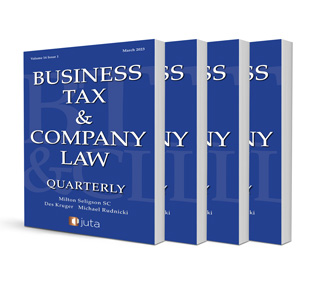
Purpose Requirement of the GAAR: Rethinking the ‘Subjective’ vs ‘Objective’ Debate
Author: Ed Liptak
ISSN: 2219-1585
Affiliations: Independent Tax Person Extraordinaire
Source: Business Tax & Company Law Quarterly, Volume 14 Issue 3, 2023, p. 1 – 14
Abstract
The current general anti-avoidance rule (GAAR) was enacted in 2006. Its overriding goal was to provide a more consistent and effective determent to what the legislation termed ‘impermissible tax avoidance arrangements’. As the SARS Discussion Paper on Tax Avoidance and Section 103 made clear, a major problem facing the fiscus was the growth of a tax avoidance industry in which extremely complex tax shelter products were designed and marketed to taxpayers. This development reflected a shift from prior practice in which taxpayers approached advisors to obtain advice on specific problems to one in which promoters marketed carefully prearranged products to clients. These products were typically sold on a ‘black box’ basis, which hid the specific inner workings of those tax shelter products. Amongst other things, this approach enabled promoters the ability to protect their so-called intellectual property, while giving clients the opportunity to use ignorance or ‘plausible deniability’ as a defence against the GAAR. To counter this problem and to resolve inconsistent applications of former section 103, in which two taxpayers could enter into identical tax shelter products but obtain different results depending upon their subjective state of mind, Parliament introduced a hybrid test in which the subjective purpose of a taxpayer must be tested against all of the relevant facts and circumstances of the case, including the purpose of the avoidance arrangement in question. It is a hybrid approach, in which the relative weight of the objective and subjective components will depend upon the circumstances of the case. Tax shelter products are meticulously designed by their promoters for one purpose — to generate a tax benefit without having a significant impact upon a taxpayer’s business operations and to be as risk-free as humanly possible. It is in these situations that the objective purpose of an avoidance arrangement is of paramount importance, particularly where these tax shelter products have been added to otherwise straightforward commercial transactions. As a result, taxpayers should no longer be able to hide behind either their ignorance or the purpose of a larger arrangement into which a tax shelter product has been inserted, to defeat the GAAR.